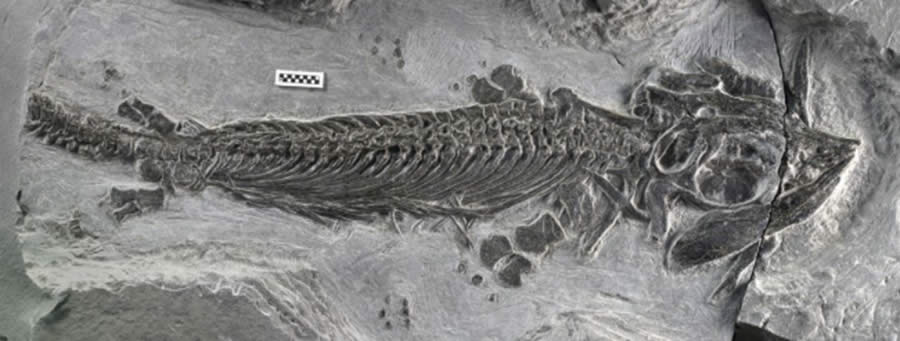
Triassic Fossil Said to be a Transitional Ichthyosaur
News to Know
Abstract
Did ancient ichthyosaurs march from land to sea in Triassic China?
News Source
- National Geographic: First Amphibious “Sea Monster” Found; Fills Evolutionary Gap
Ichthyosaurs are extinct marine reptiles. Up to 65 feet long with fish-like bodies, flippers, a dorsal fin, and tails suited for swimming, ichthyosaurs (literally, “fish-lizards”) were well adapted for life in the water. They appear “suddenly” in the fossil record in rock conventionally dated about 250 million years ago, and hundreds of ichthyosaur fossils have been found. There are even fossilized ichthyosaurs preserved in the act of giving birth. What has not been found, despite a century and a half of searching, is the evolutionary ancestor of ichthyosaurs. Scientists reporting in Nature claim to have found one—an amphibious version.

This fossil is a newly identified species of marine reptile, Cartorhynchus lenticarpus. Researchers have identified it as an ichthyosaur though it differs in many ways from known ichthyosaurs. Its snout is much shorter, for instance. It is also much smaller—probably only 40 cm long assuming it had a tail nearly as long as its body. Typical ichthyosaurs reached 10 feet, but up to 65 feet, in length. Thinking its remarkably small size and unusually bendable flippers may have made it possible for it to maneuver on land like a seal, they propose that it is a missing link to the marine reptile ichthyosaurs. They contend it evolved from land reptiles in the 4 million years that supposedly elapsed between the most recent mass extinction to flourish in Triassic era seas. This conclusion is based on numerous worldview based assumptions, not observational science. Scale bar = 1 cm. Image: Ryosuke Motani/UC Davis through National Geographic

This is a young Stenopterygius Ichthyosaur in a Hamburg zoological museum. Like other typical ichthyosaurs, this one had flippers, a long tail, and a long beak-like snout. Compare it to the short snout on the newly discovered fossil of Cartorhynchus lenticarpus. Because evolutionists believe these animals evolved from land reptiles over millions of years, they believe the short snout was more suited to land and therefore was an evolutionary transition. Yet a series of fossils—the remains of distinct diverse organisms with a variety of similarities and differences—does not demonstrate they evolved into one another but only that diverse organisms were buried over a short period of time in association with the global Flood about 4,350 years ago. Image: Wikipedia Commons
Making Fossils Fit the Bill
Since evolutionists believe fish evolved into terrestrial vertebrates, they are forced to conclude that marine mammals (like whales) and marine reptiles (like ichthyosaurs) evolved from terrestrial counterparts. Evolutionists have tried in vain to find transitional forms between completely different kinds of organisms, but that has never stopped them from claiming they have them. The assertion that ancient fish could rise up and walk out onto land as terrestrial vertebrates is fishy enough. But the claim that whales and ichthyosaurs evolved from an ancient march of terrestrials back to the sea has proven even more difficult to contrive.1
Ryosuke Motani,2 a leader in the ongoing quest to find some terrestrial ancestors for ichthyosaurs, believes a newly discovered fossil from Chinese Lower Triassic rock may have been sufficiently amphibious to fit the bill. Cartorhynchus lenticarpus, estimated to be less than 16 inches long3 if its tail were present, is considerably smaller than even the typical 10-foot long ichthyosaur.4 The wrist bones in its proportionately large flippers seem more mobile than usual for ichthyosaurs. Its smaller size, coupled with large flippers that appear to have been fairly bendable, has led the researchers to speculate that this reptile may have been able to move around on land like a seal.
The researchers also report the fossil’s ribs seemed proportionately thicker than typical for ichthyosaurs. They speculate that thicker bones equipped the ancestral animal with the mass to fight its way through coastal waves to enable its later descendants to make their new home in the sea.
In addition to assuming that this newly identified species was a transitional ichthyosaur because it might have been able to scoot about on land like a seal and battle its way to the open sea, Motani and colleagues believe Cartorhynchus was transitional in its eating habits. Known ichthyosaurs have a fairly long beak-like snout that would have served well to grab passing prey, but the snout on Cartorhynchus was short and stubby, and it had no teeth. Therefore, they propose that it was a suction feeder, slurping up its food rather than snatching it from the water.
Ichthyosaurs were marine reptiles that lived in the pre-Flood world. Was Cartorhynchus a variety of ichthyosaur? Given its unique skull, small size, and other differences when compared with the hundreds of known ichthyosaur specimens, it might be a different marine reptile altogether. Lead author of the study Ryosuke Motani even says, “When I first saw the animal, I was really puzzled. By all means, this specimen is indeed very distinct from any ichthyosaur I have seen.”
Roots of Speculation
But evolutionists need a transitional form to bridge the gap from land reptiles to ichthyosaurs. They need an animal that looks like it could still maneuver on land but thrive in the sea. “An amphibious animal was somehow missing from the ichthyosaur record, and this animal fits that picture very nicely,” Motani explains. The authors write that the reptile’s small size and big flippers “probably allowed limited terrestrial locomotion” and that the flippers “may well have allowed limited terrestrial locomotion,” the wrist anatomy “enabling seal-like flipper bending on land.”5
Answers in Genesis geologist Dr. Andrew Snelling notes how much more the media and the researchers are claiming than they could possibly know:
There isn’t much to say, because they haven’t found much—just one fossil, and an incomplete one at that. It is interesting to read the technical paper and the news reports side-by-side to compare the claims. In the National Geographic News they report “a new species of dinosaur-era reptile that could live on both land and in water”. However, in the Nature technical paper we read the skeleton only “indicates possible amphibious habits”!5 Furthermore, the tail wasn’t found with the fossil, so how can one be sure how and where the creature lived, especially when all we have are bones, and we have never observed this creature alive.
All the fanfare about the relationship between this and other fossils in the same strata sequence is based on the assumption, not observation, that these rock layers were laid down over millions of years and so the fossils found buried in them represent creatures that lived and died through those millions of years. Thus any differences between successive fossils are claimed to be due to evolutionary changes. However, the only thing we know for sure is that this is the order in which these creatures were buried, because we observe them today buried in different layers. Thus it is only valid to interpret this sequence of fossils as a burial order. All the time is assumed. However, present experimental and observation evidence today demonstrates that thick sequences of sediment layers can be deposited within hours to days under catastrophic flood conditions. The beds in which these fossils were found are in total only 59 meters thick, yet a sequence of sediment layers of much greater thickness was observed to be deposited at a result of the May 1980 Mount St Helens eruption!
Only imagination and the evolutionists’ need to find transitional forms connect the ancestral dots between different kinds of organisms that are observably separated only by distance in the fossil record, not by millions of years of real time. This animal is apparently a marine reptile, but possessing some but not all characteristics of ichthyosaurs does not mean it was a transitional form. Was it even amphibious?
Dr. Snelling comments on the speculative stretches in the study:
The short snout, thick bones and unusually large flippers do not automatically imply this creature had land-dwelling capabilities. Large flippers are good for swimming. Yet even if it did move between the water and land, it does not prove that this was somehow a supposed “missing link,” an evolutionary transitional form. Seals have large flippers and can swim as well as waddle on land, but they only reproduce after their own kind. This creature, known from only one fossil, may simply be a slightly different variety within a created kind. And since we can’t test whether it could reproduce with ichthyosaurs, because these creatures are not alive today to observe, we cannot tell whether they could interbreed or are in any way related. So the evolutionists are free to continue concocting their “just-so stories”.
God created the kinds of animals that swim in the sea and those that fly on the fifth day of Creation Week, about 6,000 years ago, just one day before He created all kinds of land animals and man. We infer from Genesis 1 that those animals all reproduce and vary only within their created kinds. That is exactly what we see them doing in biology. They don’t evolve into new kinds of animals because they were not designed to do so (as inferred from Genesis) and because they do not have any way to obtain the genetic information to become something different (as inferred from scientific observation!).
This marine reptile was not on an evolutionary march to the sea. Based on its preservation in the fossil record, we can infer that this now-extinct animal along with billions of others descended from the original kinds God created was catastrophically buried in the upheavals of the global Flood.
Further Reading
- “The Intriguing Ichthyosaur--an Evolutionary Fish Story?”
- Ichthyosaurs—Created to Live in the Sea
- Review: Your Inner Reptile
- Fossil Evidence of Whale Evolution?
- Whale Skull Equipped for Sonar Shows Echolocation Appears Abruptly in the Fossil Record
- Walking Whales, Nested Hierarchies, and Chimeras: Do They Exist?
- Ancient Whales and How Their Skulls Affected Directional Hearing
- Does a ‘Transitional Form’ Replace One Gap with Two Gaps?
- Doesn’t the Order of Fossils in the Rock Record Favor Long Ages?
For More Information: Get Answers
Remember, if you see a news story that might merit some attention, let us know about it! (Note: if the story originates from the Associated Press, FOX News, MSNBC, the New York Times, or another major national media outlet, we will most likely have already heard about it.) And thanks to all of our readers who have submitted great news tips to us. If you didn’t catch all the latest News to Know, why not take a look to see what you’ve missed?
(Please note that links will take you directly to the source. Answers in Genesis is not responsible for content on the websites to which we refer. For more information, please see our Privacy Policy.)
Footnotes
-
As mentioned in the study, evolutionists often attribute the appalling lack of transitional forms to the incompleteness of the fossil record. Answers in Genesis geologist Dr. Andrew Snelling disputes this claim, pointing out that even evolutionists see the richness of the fossil record:
As for the claim by these paleontologists in their Nature paper about the “incompleteness of the fossil record,” that has been debunked for many years, ever since evolutionary paleontologist David Raup of the University of Chicago wrote in 1979 that the fossil record is unimaginably rich. On the other hand, Dr. Kurt Wise, who trained under both David Raup and the famous Harvard evolutionist Stephen Jay Gould, has convincingly shown that the fossil record is exceptionally complete, and what we find would be exactly what would be predicted to be found if the fossil record was generated by the rapid burial of creatures as their habitats were progressively overwhelmed by the rising waters of a catastrophic global Flood.
-
Back in 1998, Motani and another group of colleagues reported they had found a primitive ichthyosaur, Utatsusaurus, exhibiting features midway between terrestrial reptiles and more highly evolved ichthyosaurs. Despite these claims, Utatsusaurus was just an ichthyosaur. Another acknowledged expert in the field, evolutionist Michael Benton, wrote that Utatsusaurus had “typical ichthyosaurian characters” and was an ichthyosaur (as discussed in “The Intriguing Ichthyosaur—an Evolutionary Fish Story?”)
Corroborating this assessment, earlier this year a study of Utatsusaurus confirmed that its bone histology was most consistent with “active swimming in an open marine environment” (Nakajima, 2014). In fact, those characteristics that some wish to call primitive—a longer straighter tail and a more slender body than some other presumably more advanced ichthyosaurs—didn’t seem to hold Utatsusaurus back at all. Researchers write, “This basal ichthyosaur, with its elongate body, was already more adapted to an aquatic lifestyle than expected from its morphology, and the process of adaptation to a marine lifestyle was already well advanced by the Early Triassic” (Nakajima, 2014).
In other words, score “zero” for Utatsusaurus as a transitional form.
(Michael Benton’s opinion referenced in www.icr.org/article/intriguing-ichthyosaur-evolutionary . Quotes from 2014 study are from Y. Nakajima et al., “Osteohistology of the early Triassic ichthyopterygian reptile Utatsusaurus hataii: implications for early ichthyosaur biology,” Acta Palaeontologica Polonica 59, no. 2 (June 2014): 343ff, dxdoi.org.ezproxy.liberty.edu:2048/10.4202/app.2012.0045.
- The actual fossil is 21.4 centimeters long, about 8.4 inches. If it is an ichthyosaur and has a typical ichthyosaur tail, researchers believe it would be about 40 cm long. From Ryosuke Motani et al., “A basal ichthyosauriform with a short snout from the Lower Triassic of China,” Nature (5 November 2014), doi:10.1038/nature13866.
- Motani and colleagues suspect it is an adult. They write, “We consider the holotype to be almost, if not fully, mature. However, with only one specimen available, the possibility of immaturity cannot be completely rejected. It is unlikely that Cartorhynchus is a young individual of a known species.” From Ryosuke Motani et al., “A basal ichthyosauriform with a short snout from the Lower Triassic of China,” Nature (5 November 2014), doi:10.1038/nature13866.
- Ryosuke Motani et al., “A basal ichthyosauriform with a short snout from the Lower Triassic of China,” Nature (5 November 2014), doi:10.1038/nature13866.
Recommended Resources

Answers in Genesis is an apologetics ministry, dedicated to helping Christians defend their faith and proclaim the good news of Jesus Christ.
- Customer Service 800.778.3390
- © 2024 Answers in Genesis





